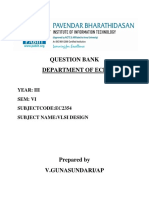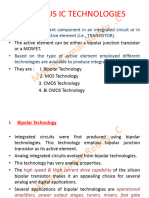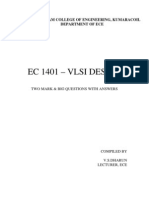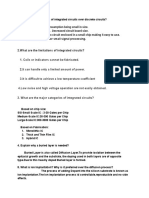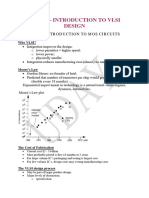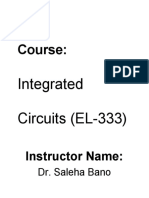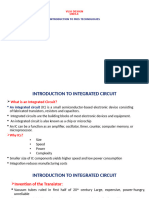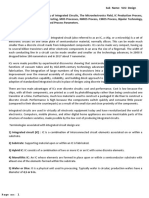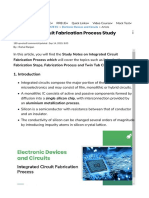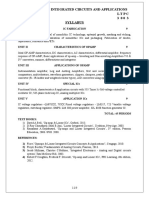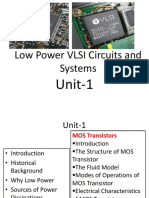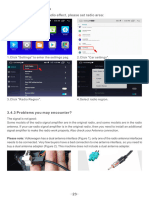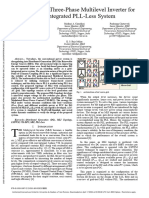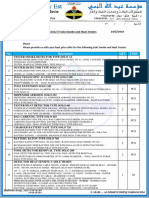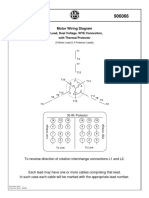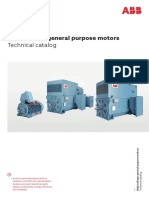Vlsi Lab Viva Questions and Answers
Vlsi Lab Viva Questions and Answers
Uploaded by
Niranjan Mamadapur Assistant Professor - ECECopyright:
Available Formats
Vlsi Lab Viva Questions and Answers
Vlsi Lab Viva Questions and Answers
Uploaded by
Niranjan Mamadapur Assistant Professor - ECECopyright
Available Formats
Share this document
Did you find this document useful?
Is this content inappropriate?
Copyright:
Available Formats
Vlsi Lab Viva Questions and Answers
Vlsi Lab Viva Questions and Answers
Uploaded by
Niranjan Mamadapur Assistant Professor - ECECopyright:
Available Formats
lOMoARcPSD|35218649
VLSI Lab Viva questions and answers
Bachelor of Engineering (Visvesvaraya Technological University)
Studocu is not sponsored or endorsed by any college or university
Downloaded by Niranjan Mamadapur (mamadapur.n@gmail.com)
lOMoARcPSD|35218649
VLSI Lab Viva questions and answers
1. What is Intrinsic and Extrinsic Semiconductor?
The pure Silicon is known as Intrinsic Semiconductor.
When impurity is added with pure Silicon, its electrical properties are varied. This is known as
Extrinsic Semiconductor.
2. What is CMOS Technology?
The fabrication of an IC using CMOS transistors is known as CMOS Technology. CMOS
transistor is nothing but an inverter, made up of an n-MOS and p-MOS transistor connected in
series.
3. Give the advantages of CMOS IC?
• Size is less
• High Speed
• Less Power Dissipation
4. What are four generations of Integration Circuits?
• SSI (Small Scale Integration)
• MSI (Medium Scale Integration)
• LSI (Large Scale Integration)
• VLSI (Very Large Scale Integration)
5. Give the variety of Integrated Circuits?
• More Specialized Circuits
• Application Specific Integrated Circuits (ASICs)
• Systems-On-Chips
6. Why NMOS technology is preferred more than PMOS technology?
N-channel transistors have greater switching speed when compared to PMOS transistors.
Hence,
NMOS is preferred than PMOS.
7. What are the different MOS layers?
• n-diffusion
• p-diffusion
• Polysilicon
• Metal
8. What are the different layers in MOS transistor?
The layers are Substrate, diffused Drain & Source, Insulator (SiO2) & Gate.
9. What are the different operating regions for an MOS transistor?
• Cutoff Region
• Non- Saturated (Linear) Region
• Saturated Region
10. What is Enhancement mode transistor?
The device that is normally cut-off with zero gate bias is called Enhancement mode transistor.
11. What is Depletion mode device?
Downloaded by Niranjan Mamadapur (mamadapur.n@gmail.com)
lOMoARcPSD|35218649
The Device that conducts with zero gate bias is called Depletion mode device.
12. When the channel is said to be pinched off?
If a large Vds is applied, this voltage will deplete the inversion layer. This Voltage effectively
pinches off the channel near the drain.
13. What are the steps involved in manufacturing of IC?
• Silicon wafer Preparation
• Epitaxial Growth
• Oxidation
• Photo-lithography
• Diffusion
• Ion Implantation
• Isolation technique
• Metallization
• Assembly processing & Packaging
14. What is meant by Epitaxy?
Epitaxy means arranging atoms in single crystal fashion upon a single crystal substrate.
15. What are the processes involved in photo lithography?
(1) Masking process (2) Photo etching process.
These are important processes involved in photolithography.
16. What is the purpose of masking in fabrication of IC?
Masking is used to identify the location in which Ion-Implantation should not take place.
17. What lire the materials used for masking?
Photo resist, Si02, SiN, Poly Silicon.
18. What are the types of Photo etching?
Wet etching and dry etching are the types of photo etching.
19. What is diffusion process? What are doping impurities?
Diffusion is a process in which impurities are diffused into the Silicon chip at 1000 C
temperature
20. What is Ion-Implantation process?
It is process in which the Si material is doped with an impurity by making the accelerated
impurity atoms to strike the Si layer at high temperature.
21. What are the various Silicon wafer Preparation?
• Crystal growth & doping
• Ingot trimming & grinding
• Ingot slicing
• Wafer polishing & etching
• Wafer cleaning.
22. What are the different types of oxidation?
The two types of oxidation are Dry & Wet Oxidation.
Downloaded by Niranjan Mamadapur (mamadapur.n@gmail.com)
lOMoARcPSD|35218649
23. What is Isolation?
It is a process used to provide electrical isolation between different components and
interconnections.
24. Give the different types of CMOS process?
• p-well process
• n-well process
• twin-tub process
• SOI process
25. What is Channel-stop Implantation?
In n-well fabrication, n-well is protected with the resist material. (Because, it should not be
affected during Boron implantation). Then Boron is implanted except n-well. The above said
process is done using photo resist mask. This type of implantation is known as Channel-stop
implantation.
26. What is LOCOS?
LOCOS mean Local Oxidation of Silicon. This is one type of oxide construction.
27. What is SWAMI?
SWAMI means Side Wall Masked Isolation. It is used to reduce bird's beak effect.
28. What is LDD?
LDD means Lightly Doped Drain Structures. It is used for implantation of n- region in n-well
process.
29. What is Twin-tub process? Why it is called so?
Twin-tub process is one of the CMOS technologies. Two wells (the other name for well is Tub)
are created in this process. So, because of these two tubs, this process is known as Twin-tub
process.
30. What are the steps involved in twin-tub process?
• Tub Formation
• Thin-oxide Construction
• Source & Drain Implantation
• Contact cut definition
• Metallization.
31. What are the special features of Twin-tub process?
In Twin-tub process, Threshold voltage, body effects of n and p devices are independently
optimized.
32. What are the advantages of Twin-tub process?
Advantages of Twin-tub process are (1) Separate optimized wells are available. (2) Balanced
performance is obtained for n and p transistors.
33. What is SOI? What is the material used as Insulator?
SOI means Silicon-on-Insulator. In this process, a Silicon based transistor is built on an
insulating material like Sapphire or SiO2.
34. What are the advantages and disadvantages of SOI process?
Downloaded by Niranjan Mamadapur (mamadapur.n@gmail.com)
lOMoARcPSD|35218649
Advantages of SOI process: 1. There is no well formation in this process. 2. There is no field-
Inversion problem. 3. There is no body effect problem.
Disadvantages of SOI process: 1. It is very difficult to protect inputs in this process. 2. Device
gain is low. 3. The coupling capacitance between wires always exists.
35. What are the advantages of CMOS process?
• Low Input Impedance
• Low delay Sensitivity to load.
36. What are the various etching processes used in SOI process?
Various etching processes used in SOI are, Dry and Wet etching
37. What is BiCMOS Technology?
It is the combination of Bipolar technology & CMOS technology.
38. What are the basic processing steps involved in BiCMOS process?
Additional masks defining P base region
• N Collector area
• Buried Sub collector (SCCD)
• Processing steps in CMOS process
39. What is meant by interconnect? What are the types are of interconnect?
Interconnect means connection between various components in an IC.
Types of Inter connect: 1. Metal Inter connect 2. PolySilicon Inter connect 3. Local Inter
connect.
40. What is Silicide?
The combination of Silicon and tantaleum is known as Silicide. It is used as gate material in
Polysilicon Interconnect.
41. What is Polycide?
The combination of Silicide and Polysilicon is known as Polycide. It is used as gate material.
42. What is Stick diagram?
The diagram which conveys the layer information through the use of various colours is known as
Stick diagram. It is also the cartoon of a chip layout.
43. What are the uses of Stick diagram?
• It can be drawn much easier and faster than a complex layout.
• These are especially important tools for layout built from large cells.
44. Give the various color coding used in stick diagram?
• Green - n-diffusion
• Red - polysilicon
• Blue - metal
• Yellow - implant
• Black - contact areas.
45. Compare between CMOS and bipolar technologies.
CMOS Technology Bi-polar Technology
• Low static power dissipation
Downloaded by Niranjan Mamadapur (mamadapur.n@gmail.com)
lOMoARcPSD|35218649
• High input impedance (low drive current)
Scalable threshold voltage
• High noise margin
• High packing density
• High delay sensitivity to load (fanout limitations)
• Low output drive current " Low gm (gm ³ Vin)
• Bidirectional capability
• A near ideal switching device7
• High power dissipation
• Low input impedance (high drive current)
• Low voltage swing logic
• Low packing density
• Low delay sensitivity to load
• High output drive current
• High gm (gm a eVin)
• High ft at low current
• Essentially unidirectional
46. Define Threshold voltage in CMOS?
The Threshold voltage, VT for a MOS transistor can be defined as the voltage applied between
the gate and the source of the MOS transistor below which the drain to source current,
IDS effectively drops to zero.
47. What is Body effect?
The threshold voltage VTh is not a constant with respect to the voltage difference between the
substrate and the source of MOS transistor. This effect is called substrate-bias effect or body
effect.
48. What is Channel-length modulation?
The current between drain and source terminals is constant and independent of the
applied voltage over the terminals. This is not entirely correct. The effective length of the
conductive channel is actually modulated by the applied VDS, increasing VDS causes the
depletion region at the drain junction to grow, reducing the length of the effective channel.
Scalable threshold voltage
48. What is Channel-length modulation?
The current between drain and source terminals is constant and independent of the applied
voltage over the terminals. This is not entirely correct. The effective length of the conductive
channel is actually modulated by the applied VDS, increasing VDS causes the depletion region
at the drain junction to grow, reducing the length of the effective channel.
49. What is Latch – up?
Latch-up is a condition in which the parasitic components give rise to the establishment of low
resistance conducting paths between VDD and VSS with disastrous results. Careful control
during fabrication is necessary to avoid this problem.
50. What is demarcation line?
Demarcation line is an imaginary line used in stick diagram, to separate p-MOS and n-MOS
transistors.
All p-MOS transistors are placed above demarcation line and n-MOS below the demarcation line
51. What are the two types of Layout design rules?
Lambda design rules and micron rules are major types of layout design rules.
Downloaded by Niranjan Mamadapur (mamadapur.n@gmail.com)
lOMoARcPSD|35218649
52. What is Lay-out design rule?
The rules followed to prepare the photo mask are known as Layout design rules.
53. What are LVS and DRL tools?
LVS means Layout Versus Schematic. It checks layout against schematic diagram. It is very
important to verify layout.
DRC means Design Rule Checker. This tool checks every occurrence of design rule list on
layout. Width, spacing of every metal line in layout are checked with this tool.
54. What is instance? What is instancing?
To construct big complex circuit, the basic cells (small cells) can be copied. This process is
known as Instancing. The cell which is copied is known as Instance.
55. What is flat cell?
The cell which is independent and not related to other objects is known as flat cell.
56. What are the cells available in primitive library?
NOT, NAND, NOR, are the basic cells in primitive library.
57. What is Design Hierarchy?
When we want to design AND-4 input gate, we use NAND-2 and NOR-2 basic blocks. By
combining NAND-2 and NOR-2, we create AND-4 input gate. This is known as Design
Hierarchy.
58. Which is the software used in this lab?
cadence .
59. What are the other alternative software apart from cadence used for VLSI design?
Microwind, Tanner, Hspice, Pspice, Mentor graphics, Xilinx etc…
60. Name the Simulator used in cadence for simulation ?
Insim or incisive simulator
61. What is RTL ?
RTL stands for Register Transfer Level. It is a high-level hardware description language (HDL)
used for defining digital circuits. The most popular RTL languages are VHDL and Verilog.
62. What is the difference between simulation and synthesis?
Simulation is used to verify the functionality of the circuit.. a)Functional Simulation: study of
ckt's operation independent of timing parameters and gate delays. b) Timing Simulation :study
including estimated delays, verify setup, hold and other timing requirements of devices like flip
flops are met
Synthesis: One of the foremost in back end steps where by synthesizing is nothing but
converting VHDL or VERILOG description to a set of primitives or components(as in
FPGA'S)to fit into the target technology. Basically the synthesis tools convert the design
description into equations or components.
63. Which is the tool used for analog design of vlsi circuits?
Virtuoso
Downloaded by Niranjan Mamadapur (mamadapur.n@gmail.com)
lOMoARcPSD|35218649
64. What is the platform for virtuoso?
Encounter
65. Why don’t we use just one NMOS or PMOS transistor as a transmission gate?
Because we can't get full voltage swing with only NMOS or PMOS .We have to use both of
them together for that purpose.
66. Why don’t we use just one NMOS or PMOS transistor as a transmission gate?
nmos passes a good 0 and a degraded 1 , whereas pmos passes a good 1 and bad 0. for
pass transistor, both voltage levels need to be passed and hence both nmos and pmos need to be
used.
67. What are set up time & hold time constraints? What do they signify?
Setup time: Time before the active clock edge of the flip-flop, the input should be stable. If the
signal changes state during this interval, the output of that flip-flop cannot be predictable (called
metastable).
Hold Time: The after the active clock edge of the flip-flop, the input should be stable. If the
signal changes during this interval, the output of that flip-flop cannot be predictable (called
metastable).
68. Explain Clock Skew?
clock skew is the time difference between the arrival of active clock edge to different flip-flops’
of the same chip.
69. Why is not NAND gate preferred over NOR gate for fabrication?
NAND is a better gate for design than NOR because at the transistor level the mobility of
electrons is normally three times that of holes compared to NOR and thus the NAND is a faster
gate. Additionally, the gate-leakage in NAND structures is much lower.
70. What is Body Effect?
In general multiple MOS devices are made on a common substrate. As a result, the substrate
voltage of all devices is normally equal. However while connecting the devices serially this may
result in an increase in source-to-substrate voltage as we proceed vertically along the series chain
(Vsb1=0, Vsb2 0).Which results Vth2>Vth1.
71. Why is the substrate in NMOS connected to Ground and in PMOS to VDD?
we try to reverse bias not the channel and the substrate but we try to maintain the drain, source
junctions reverse biased with respect to the substrate so that we don’t loose our current into the
substrate.
72. What is the fundamental difference between a MOSFET and BJT ?
In MOSFET, current flow is either due to electrons (n-channel MOS) or due to holes(p-channel
MOS) - In BJT, we see current due to both the carriers..Electrons and holes. BJT is a current
controlled device and MOSFET is a voltage controlled device
73. In CMOS technology, in digital design, why do we design the size of pmos to be higher
than the nmos. What determines the size of pmos wrt nmos. Though this is a simple
question try to list all the reasons possible?
In PMOS the carriers are holes whose mobility is less[ aprrox half ] than the electrons, the
carriers in NMOS. That means PMOS is slower than an NMOS. In CMOS technology, nmos
helps in pulling down the output to ground PMOS helps in pulling up the output to Vdd. If the
Downloaded by Niranjan Mamadapur (mamadapur.n@gmail.com)
lOMoARcPSD|35218649
sizes of PMOS and NMOS are the same, then PMOS takes long time to charge up the output
node. If we have a larger PMOS than there will be more carriers to charge the node quickly and
overcome the slow nature of PMOS . Basically we do all this to get equal rise and fall times for
the output node.
74. Why PMOS and NMOS are sized equally in a Transmission Gates?
In Transmission Gate, PMOS and NMOS aid each other rather competing with each other. That's
the reason why we need not size them like in CMOS. In CMOS design we have NMOS and
PMOS competing which is the reason we try to size them proportional to their mobility.
75. What happens when the PMOS and NMOS are interchanged with one another in an
inverter?
If the source & drain also connected properly...it acts as a buffer. But suppose input is logic 1
O/P will be degraded 1 Similarly degraded 0
76. Why are pMOS transistor networks generally used to produce high signals, while
nMOS networks are used to product low signals?
This is because threshold voltage effect. A nMOS device cannot drive a full 1 or high and pMOS
can’t drive full '0' or low. The maximum voltage level in nMOS and minimum voltage level in
pMOS are limited by threshold voltage. Both nMOS and pMOS do not give rail to rail swing.
77. What’s the difference between Testing & Verification?
Testing: A manufacturing step that ensures that the physical device , manufactured from the
synthesized design, has no manufacturing defect.
Verification: Predictive analysis to ensure that the synthesized design, when manufactured, will
perform the given I/O function
78. What is Latch Up? Explain Latch Up with cross section of a CMOS Inverter. How do
you avoid Latch Up?
A latch up is the inadvertent creation of a low-impedance path between the power supply rails of
an electronic component, triggering a parasitic structure(The parasitic structure is usually
equivalent to a thyristor or SCR), which then acts as a short circuit, disrupting proper functioning
of the part. Depending on the circuits involved, the amount of current flow produced by this
mechanism can be large enough to result in permanent destruction of the device due to electrical
over stress - EOS
79. What is slack?
The slack is the time delay difference from the expected delay(1/clock) to the actual delay in a
particular path. Slack may be +ve or -ve.
80. Explain how logical gates are controlled by Boolean logic?
In Boolean algebra, the true state is denoted by the number one, referred as logic one or logic
high. While, the false state is represented by the number zero, called logic zero or logic low.
And in the digital electronic, the logic high is denoted by the presence of a voltage potential.
81. Mention what are the different gates where Boolean logic are applicable?
• NOT Gate: It has one out input and one output. For example, if the value of A= 0 then
the Value of B=1 and vice versa
• AND Gate: It has one output due to the combination of two output. For example, if the
value of A and B= 1 then value of Q should be 1
• OR Gate: Either of the value will show the same output. For example, if the value of A
Downloaded by Niranjan Mamadapur (mamadapur.n@gmail.com)
lOMoARcPSD|35218649
is 1 or B is 0 then value of Q is 1
• These are the basic three types of gates where Boolean logic work, apart from these, other
gates that are functional works with the combination of these three basic gates, they are
XNOR gate,NAND gate, Nor gate and XOR gate.
82. Explain how binary number can give a signal or convert into a digital signal?
Binary number consists of either 0 or 1, in simple words number 1 represents the ON state and
number 0 represents OFF state. These binary numbers can combine billion of machines into one
machines or circuit and operate those machines by performing arithmetic calculations and sorting
operations.
83. Mention what is the difference between the TTL chips and CMOS chips?
TTL Chips CMOS Chips
÷ TTL chips for transistor transistor logic. CMOS stands for Complementary
It uses two Bi- Metal Oxide Semi-conductor. It is also
polar Junction Transistors an integrated chip but used field effect
in the design of each logic gate transistors in the design
TTL chips can consist of a substantial CMOS has greater density for logic
number of parts like resistors gates. In a CMOS chip, single logic gate
can comprise of as little as two FETs
TTLS chip consumes lot more power CMOS chips consume less power. A
especially at rest. A single gate in TTL single CMOS chip consume about
chip consumes about mW of power 10nW of power
TTL chips can be used in computers CMOS chip is used in Mobile phones
84. Explain what is a sequential circuit?
A sequential circuit is a circuit which is created by logic gates such that the required logic at the
output depends not only on the current input logic conditions, but also on the sequences
past inputs and outputs.
85. Explain how Verilog is different to normal programming language?
Verilog can be different to normal programming language in following aspects
• Simulation time concept
• Multiple threads
• Basic circuit concepts like primitive gates and network connections
86. Explain what is Verilog?
Verilog is an HDL (Hardware Description Language) for describing electronic circuits and
systems. In Verilog, circuit components are prepared inside a Module. It contains both
behavioral and structural statements. Structural statements signify circuit components like logic
gates, counters and micro-processors. Behavioral statements represent programming aspects like
loops, if-then statements and stimulus vectors.
87. In Verilog code what does “timescale 1 ns/ 1 ps” signifies?
In Verilog code, the unit of time is 1 ns and the accuracy/precision will be upto 1ps.
88. Mention what are the two types of procedural blocks in Verilog?
Downloaded by Niranjan Mamadapur (mamadapur.n@gmail.com)
lOMoARcPSD|35218649
The two types of procedural blocks in Verilog are
• Initial: Initial blocks runs only once at time zero
• Always: This block loop to execute over and again and executes always, as the name
suggests
89. Explain why present VLSI circuits use MOSFETs instead of BJTs?
In comparison to BJT, MOSFETS can be made very compact as they occupy very small silicon
area on IC chip and also in term of manufacturing they are relatively simple. Moreover, digital
and memory ICs can be employed with circuits that use only MOSFETs, i.e., diodes, resistors,
etc.
90. Mention what are three regions of operation of MOSFET and how are they used?
MOSFET has three regions of operations
• Cut-off region
• Triode region
• Saturation region
The triode and cut-off region are used to function as a switch, while, saturation region is used to
operate as an amplifier.
91. Explain what is the depletion region?
When positive voltage is transmitted across Gate, it causes the free holes (positive charge) to be
pushed back or repelled from the region of the substrate under the Gate. When these holes are
pushed down the substrate, they leave behind a carrier depletion region.
92. Explain why is the number of gate inputs to CMOS gates usually limited to four?
Higher the number of stacks, slower the gate will be. In NOR and NAND gates the number of
gates present in the stack is usually alike as the number of inputs plus one. So input are restricted
to four.
92. Explain what is multiplexer?
A multiplexer is a combination circuit which selects one of the many input signals and direct to
the only output.
Downloaded by Niranjan Mamadapur (mamadapur.n@gmail.com)
You might also like
- VLSI Design Questions With AnswersDocument5 pagesVLSI Design Questions With Answersmani_vlsi100% (4)
- VLSI Lab Viva Questions and Answers 1Document21 pagesVLSI Lab Viva Questions and Answers 1anand_duraiswamy0% (1)
- Vlsi Basic Viva Questions and Answers PDFDocument12 pagesVlsi Basic Viva Questions and Answers PDFAnonymous BVp7iZNo ratings yet
- VLSI Lab Viva Questio Ns and Answers PDF - Sushanth KJ - Academia - Edu PDFDocument7 pagesVLSI Lab Viva Questio Ns and Answers PDF - Sushanth KJ - Academia - Edu PDFVishnuNo ratings yet
- EC1401 VLSI - Question Bank (N.shanmuga Sundaram)Document35 pagesEC1401 VLSI - Question Bank (N.shanmuga Sundaram)Dr. N.Shanmugasundaram50% (2)
- VLSI Design Interview QuestionsDocument11 pagesVLSI Design Interview QuestionsRohit SomkuwarNo ratings yet
- Vlsi 2marksDocument5 pagesVlsi 2marksJenny ThanushawNo ratings yet
- Lenin Raja,: Assistant Professor / Research CoordinatorDocument5 pagesLenin Raja,: Assistant Professor / Research CoordinatorArighna BasakNo ratings yet
- Question Bank Department of Ece: Year: Iii Sem: Vi Subjectcode:Ec2354 Subject Name:Vlsi DesignDocument20 pagesQuestion Bank Department of Ece: Year: Iii Sem: Vi Subjectcode:Ec2354 Subject Name:Vlsi DesignMansi PatelNo ratings yet
- Iiiyr Visem Vlsi DesignDocument20 pagesIiiyr Visem Vlsi DesignlokeshwarrvrjcNo ratings yet
- Ic Technologies and Fabrication StepsDocument14 pagesIc Technologies and Fabrication Stepsrakeshluddu042No ratings yet
- Ec1401 Vlsi DesignDocument18 pagesEc1401 Vlsi Designanon-274152100% (3)
- VLSI Tech Intro 2024Document89 pagesVLSI Tech Intro 2024Jossan EleazarEDENNo ratings yet
- 2.what Are The Limitations of Integrated Circuits? 1. 2Document6 pages2.what Are The Limitations of Integrated Circuits? 1. 220EUEE053- MADHUBALAN.SNo ratings yet
- Ec308 UnitiDocument46 pagesEc308 Unitivsrkrishna8303No ratings yet
- 219 - EE8451, EE6303 Linear Integrated Circuits and Applications LICA - 2 Marks With AnswersDocument8 pages219 - EE8451, EE6303 Linear Integrated Circuits and Applications LICA - 2 Marks With AnswersBALAKRISHNANNo ratings yet
- 2 Mark Questions & AnswersDocument6 pages2 Mark Questions & AnswersMuthu KumarNo ratings yet
- Vlsi Viva QuestionsDocument9 pagesVlsi Viva Questionssheethal rokhadeNo ratings yet
- Course:: Integrated Circuits (EL-333)Document42 pagesCourse:: Integrated Circuits (EL-333)Bushra IbrahimNo ratings yet
- Ec1401 Vlsi DesignDocument18 pagesEc1401 Vlsi DesignChaitanya PrabhuNo ratings yet
- Introduction To VLSI TechnologyDocument19 pagesIntroduction To VLSI TechnologyVikas KumarNo ratings yet
- Vlsi 2 Marks QSDocument16 pagesVlsi 2 Marks QSJay SubbareddyNo ratings yet
- Introduction To MOS TechnologiesDocument15 pagesIntroduction To MOS TechnologieslokeshwarrvrjcNo ratings yet
- VLSI IntroductionDocument23 pagesVLSI IntroductionSreenivasulu MamillaNo ratings yet
- Ec1354 Vlsi by Suresh.mDocument75 pagesEc1354 Vlsi by Suresh.mSuresh Muthu100% (1)
- Ee6303 Qa Ans RejinpaulDocument7 pagesEe6303 Qa Ans RejinpaulBALAKRISHNANNo ratings yet
- Ec1401 Vlsi DesignDocument18 pagesEc1401 Vlsi DesignSurya PrakashNo ratings yet
- EC1313 Two Marks Linear Integrated CircuitsDocument11 pagesEC1313 Two Marks Linear Integrated Circuitsmoney_kandan2004No ratings yet
- M Group: Linear Integrated Circuits (Ec1313) IC FabricationDocument17 pagesM Group: Linear Integrated Circuits (Ec1313) IC Fabricationscribdm100% (1)
- Vlsi Design Unit-IVDocument153 pagesVlsi Design Unit-IViironman1267No ratings yet
- VLSI DesignDocument169 pagesVLSI DesignSushmaNo ratings yet
- Ec 1401 - Vlsi DesignDocument22 pagesEc 1401 - Vlsi DesignPerumal NamasivayamNo ratings yet
- Cmos Technology GroupDocument56 pagesCmos Technology GroupAiman NabihahNo ratings yet
- Vlsi Question BankDocument14 pagesVlsi Question BankGokila Vani50% (2)
- 19EE44 - LIC - Unit IDocument149 pages19EE44 - LIC - Unit IGAMES TECHNo ratings yet
- Integrated Circuit Fabrication ProcessDocument14 pagesIntegrated Circuit Fabrication ProcessSanthosh DheerajNo ratings yet
- Integrated CircuitsDocument43 pagesIntegrated Circuitsgovardhan50No ratings yet
- Notes NewDocument14 pagesNotes NewPriya SirsatNo ratings yet
- Integrated CircuitsDocument4 pagesIntegrated CircuitsGurjeet ChahalNo ratings yet
- VLSI - 16marksDocument44 pagesVLSI - 16marksdheeraj.udaiNo ratings yet
- VLSI DesignDocument11 pagesVLSI DesignRishi JhaNo ratings yet
- TDALezione 16Document55 pagesTDALezione 16kamel KhalilNo ratings yet
- Fabrikasi ICDocument47 pagesFabrikasi ICNanamaliamNo ratings yet
- Ee503 - Ic Fabrication and Packaging TechnologyDocument34 pagesEe503 - Ic Fabrication and Packaging TechnologyPrevenaManiamNo ratings yet
- EE6303-Linear Integrated Circuits and Applications Q&ADocument24 pagesEE6303-Linear Integrated Circuits and Applications Q&AY RohitNo ratings yet
- Integrated Circuits: Harpreet Singh 100806043Document35 pagesIntegrated Circuits: Harpreet Singh 100806043Varinder Singh MaanNo ratings yet
- Integrated Circuit Fabrication Process Study Notes For ECEDocument9 pagesIntegrated Circuit Fabrication Process Study Notes For ECEkrishnaav100% (1)
- 5 LicaDocument26 pages5 LicaVantharAlaNo ratings yet
- Unit 1 MOS Fabrication TechnologyDocument86 pagesUnit 1 MOS Fabrication TechnologyChinna ChowdaryNo ratings yet
- Automated Optical Inspection: Advancements in Computer Vision TechnologyFrom EverandAutomated Optical Inspection: Advancements in Computer Vision TechnologyNo ratings yet
- Innovations Beyond the Wires: Exploring the Frontiers of Electrical EngineeringFrom EverandInnovations Beyond the Wires: Exploring the Frontiers of Electrical EngineeringNo ratings yet
- BICSI RCDD Registered Communications Distribution Designer Exam Prep And Dumps RCDD-001 Exam Guidebook Updated QuestionsFrom EverandBICSI RCDD Registered Communications Distribution Designer Exam Prep And Dumps RCDD-001 Exam Guidebook Updated QuestionsNo ratings yet
- Millimeter-Wave Receiver Concepts for 77 GHz Automotive Radar in Silicon-Germanium TechnologyFrom EverandMillimeter-Wave Receiver Concepts for 77 GHz Automotive Radar in Silicon-Germanium TechnologyNo ratings yet
- Connection-Oriented Networks: SONET/SDH, ATM, MPLS and Optical NetworksFrom EverandConnection-Oriented Networks: SONET/SDH, ATM, MPLS and Optical NetworksNo ratings yet
- Future Trends in Microelectronics: Journey into the UnknownFrom EverandFuture Trends in Microelectronics: Journey into the UnknownRating: 1 out of 5 stars1/5 (1)
- New Sensors and Processing ChainFrom EverandNew Sensors and Processing ChainJean-Hugh ThomasNo ratings yet
- ACT - 1 - Paper 1 ResonanceDocument27 pagesACT - 1 - Paper 1 ResonanceTridipta MishraNo ratings yet
- Aucr 2021Document114 pagesAucr 2021mnagaarjun323No ratings yet
- Manual Omega M4463 - Transmisor de NivelDocument24 pagesManual Omega M4463 - Transmisor de Nivel-SILENCE-No ratings yet
- TLH PDFDocument2 pagesTLH PDFTravis WoodNo ratings yet
- Android Player Manual (T3) (25-28) ...Document4 pagesAndroid Player Manual (T3) (25-28) ...wujekmati7No ratings yet
- 1001 Mitsubishi Lancer Evo IX.Document1,000 pages1001 Mitsubishi Lancer Evo IX.seregap84100% (2)
- NJM072B/082B/072/082: Dual J-Fet Input Operational AmplifierDocument5 pagesNJM072B/082B/072/082: Dual J-Fet Input Operational AmplifierMatty EmmaNo ratings yet
- Unit 2 PSOC Notes FinalDocument69 pagesUnit 2 PSOC Notes FinalBarath Biber100% (1)
- DMC AssemblyDocument10 pagesDMC Assemblyapi-310974258No ratings yet
- General Specification: Commercial Grade, Smart HVAC Switching Control Model No.: MWS-120, MWS-240Document5 pagesGeneral Specification: Commercial Grade, Smart HVAC Switching Control Model No.: MWS-120, MWS-240MusembiNo ratings yet
- XLPE Submarine Cable Systems 2GM5007 Rev 5Document12 pagesXLPE Submarine Cable Systems 2GM5007 Rev 5Sara ArmstrongNo ratings yet
- NHP PLDocument56 pagesNHP PLrajpre1213No ratings yet
- EngPhy Module v&VIDocument100 pagesEngPhy Module v&VISanjeevNo ratings yet
- New Adaptive Decentralize Under Frequency Load-Shedding AlgorithmDocument4 pagesNew Adaptive Decentralize Under Frequency Load-Shedding AlgorithmLendi Saputro AjiNo ratings yet
- Asymmetrical Three-Phase Multilevel Inverter For Grid-Integrated PLL-Less SystemDocument7 pagesAsymmetrical Three-Phase Multilevel Inverter For Grid-Integrated PLL-Less Systemhamidamza4No ratings yet
- N Type: Product BrochureDocument9 pagesN Type: Product BrochureEka Yuniansah WidiastutyNo ratings yet
- Thermocouple PDFDocument5 pagesThermocouple PDFjayesh maliNo ratings yet
- ADuC845 847 848Document108 pagesADuC845 847 848Tim BeckNo ratings yet
- Error Control Coding Fundamentals and Applications by Shu Lin PDFDocument2 pagesError Control Coding Fundamentals and Applications by Shu Lin PDFMaggie0% (1)
- RFQ Solo Smoke and Heat TestersDocument2 pagesRFQ Solo Smoke and Heat TestersSamir AjiNo ratings yet
- DCN Pro ScanDocument231 pagesDCN Pro ScanThái NguyễnNo ratings yet
- Data Sheet: SAA4977HDocument32 pagesData Sheet: SAA4977HChaovalit JitsinthuNo ratings yet
- Motor Wiring Diagram: 12 Lead, Dual Voltage, WYE Connection, With Thermal ProtectorDocument1 pageMotor Wiring Diagram: 12 Lead, Dual Voltage, WYE Connection, With Thermal ProtectorErick Mejía FrancoNo ratings yet
- ABB HV Engineered Induction Motors CatalogDocument60 pagesABB HV Engineered Induction Motors CatalogRadu BabauNo ratings yet
- 14386l Camu 11670 Rev34 IngleseDocument253 pages14386l Camu 11670 Rev34 Inglesejohnysonycum0% (1)
- GM Install and Key Relearn Instructions FinalDocument6 pagesGM Install and Key Relearn Instructions FinalDaniel oberNo ratings yet
- Automatic Bottle Filling, Capping and Labelling System Using PLC Based ControllerDocument12 pagesAutomatic Bottle Filling, Capping and Labelling System Using PLC Based ControllerBazinNo ratings yet
- Embedded Systems (Eceg-5702) : Lecture 6: Ccs Pic C Compiler RtosDocument21 pagesEmbedded Systems (Eceg-5702) : Lecture 6: Ccs Pic C Compiler RtossmithNo ratings yet
- 83978djrcet II B.tech I Sem Edc-unit-V & Vi NotesDocument23 pages83978djrcet II B.tech I Sem Edc-unit-V & Vi NotesNicholson ZapantaNo ratings yet
- Samsung Ue49nu7172u Uwx80Document104 pagesSamsung Ue49nu7172u Uwx80kevinalleinNo ratings yet









